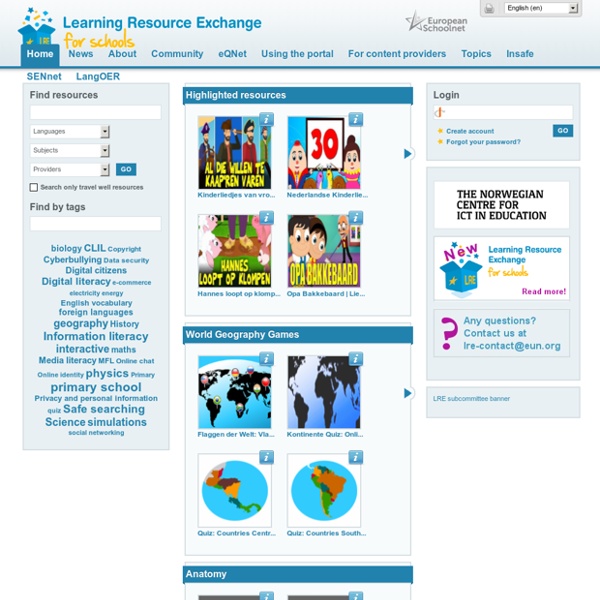



http://lreforschools.eun.org/web/guest
Related: MaterialsCS Principles for High School - Course Registration for the 2015 CSP4HS course is open. Please see Registration link above or "Register Please" button below. Please scroll to the bottom of this page to access the course lessons. You must be registered and logged in to access course content. CSP4HS provides six-weeks of free online instruction to educators who are interested in learning more about CS Principles (CS Principles), which is a new Advanced Placement course being developed by the College Board. The course will begin during the week of June 1, 2015, and end during the week of July 24 (there will be two weeks off between June 19th –July 5th). Material Results Neuroscience for Kids The entry point to an extensive site concerning the nervous system and neuroscience. The site includes descriptive materials,... see more The entry point to an extensive site concerning the nervous system and neuroscience. The site includes descriptive materials, experiments, activities, links to articles, resources for teaching neuroscience, and a listing of Internet resources related to the neurosciences.
Tech For Learners Welcome to the web-enabled search for products and services offered by EdTech companies. Are you looking for a specific tool to meet a need? Search by numerous categories to discover what products and services are provided to help you meet your learning and teaching needs for schools, districts, states, universities, the workforce, families, and learners.
Computer Science Principles What is CS Principles? In fall 2016, the College Board launched its newest AP® course, AP Computer Science Principles. The course introduces students to the foundational concepts of computer science and challenges them to explore how computing and technology can impact the world. content cs | de | en | es | et | fi | fr | hu | ka | lt | pl | pt-br | ro | ru | se Log in Join Contenido Métodos Herramientas Blown to Bits: Your Life, Liberty and the Pursuit of Happiness after the Digital Explosion The full text of the book (third printing, corrected) is available for download under a Creative Commons license (see the bottom of this page). To get the book as a single PDF file (22MB), exactly as it appears in print, click here. For each chapter, we include below links to a brief excerpt and to a PDF of the chapter. Preface
Claves y herramientas para utilizar las rúbricas en clase - aulaPlaneta Las rúbricas son herramientas de evaluación que, a modo de tabla, permiten valorar de forma detallada las tareas realizadas por los alumnos y los conocimientos y competencias adquiridos. Frente a las calificaciones tradicionales, que evalúan los trabajos de forma numérica y como un todo, las rúbricas constituyen una completa alternativa donde el profesor desgrana y define los objetivos de aprendizaje y los criterios que utilizará para valorarlos. Te ofrecemos varias claves y herramientas para elaborar y utilizar rúbricas de manera sencilla. Las rúbricas son tablas o matrices de valoración que incluyen, en su eje vertical, los aspectos de la tarea u objetivos de aprendizaje que se van a valorar, y en su eje horizontal, los criterios específicos que se utilizarán para hacerlo. En este enlace puedes consultar varios ejemplos de rúbricas para distintas tareas o actividades.
EL HOMBRE Y SUS INTERRELACIONES CON LOS PRODUCTOS TECNOLOGICOS Versión Estudiante Área Informática - Otra Edad Descripción AP Computer Science Principles - A New AP Course - Advances in AP® - The College Board AP Computer Science Principles AP Computer Science Principles introduces students to the foundational concepts of computer science and challenges them to explore how computing and technology can impact the world. With a unique focus on creative problem solving and real-world applications, AP Computer Science Principles prepares students for college and career.
Free Tools For Teachers : Small Basic Help your students start writing their first programs quickly and easily. With only 15 keywords and an inviting development environment, Small Basic is structured to help them succeed. Students who wish to advance their software development skills can also take advantage of Small Basic's online guides and e-books to help them move ahead. Small Basic makes learning programming easy, fun, and interesting How to Teach Computing: An Introduction to Concepts, Tools and Resources for Secondary Teachers "Coding is like the new literacy!" Neelie Kroes, Vice President of the European Commission. Annoyed of students being distracted by their mobile phones? Tired of seeing students falling asleep after a night of gaming? Let's turn our students from passive consumers of technology into active producers of technology.
Programme of Study - Barefoot Computing Barefoot Computing All our resources are mapped to the computer science aspects of the computing programme of study. You will find these statements below, broken down into shorter statements. You can find out more about our resources here. Click on a link below to find out about the underlying computer science concepts you need to know about for the statement and access exemplar teaching activities to use with your class. We will be adding more resources regularly! Materiales y datos de los MOOC sobre ABP y PLE Finalizados los cursos masivos en red (MOOC) sobre “Aprendizaje basado en proyectos (ABP)” y “Entornos personales de aprendizaje (PLE)”, llega el momento de hacer recopilación de los datos de participación y materiales generados. Participantes matriculados – PLE: 2.041 (España: 910) ABP: 3.790 (España: 2.221) Nº de insignias entregadas – PLE: 53 (2,6 %) ABP: 127 (3,3%)
Teaching London Computing Computing is now a core part of the UK primary school syllabus. You don’t have to use computers to teach all the topics though, and even if you have no computing background as a teacher you may be surprised how much you know! We have created a spin-off from cs4fn for younger students to find out more about the fun side of computing called A Little Bit of cs4fn.